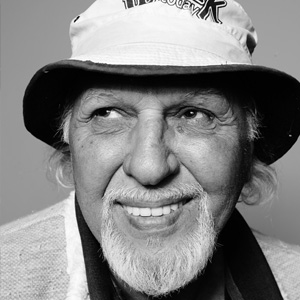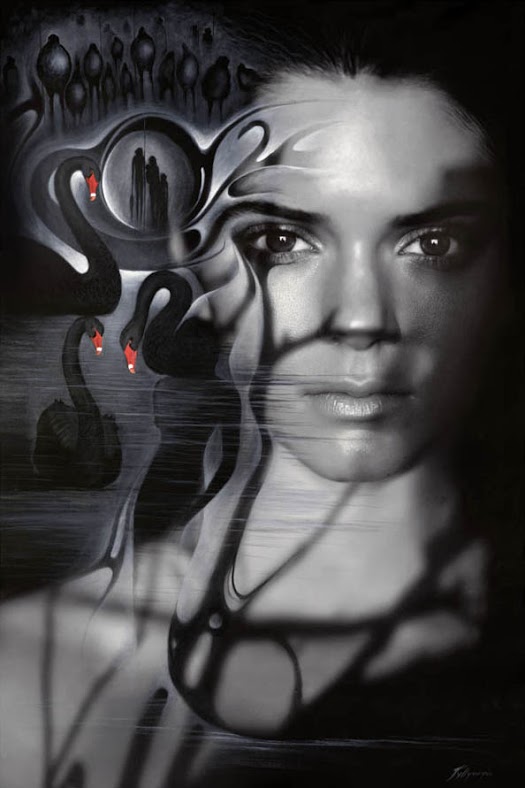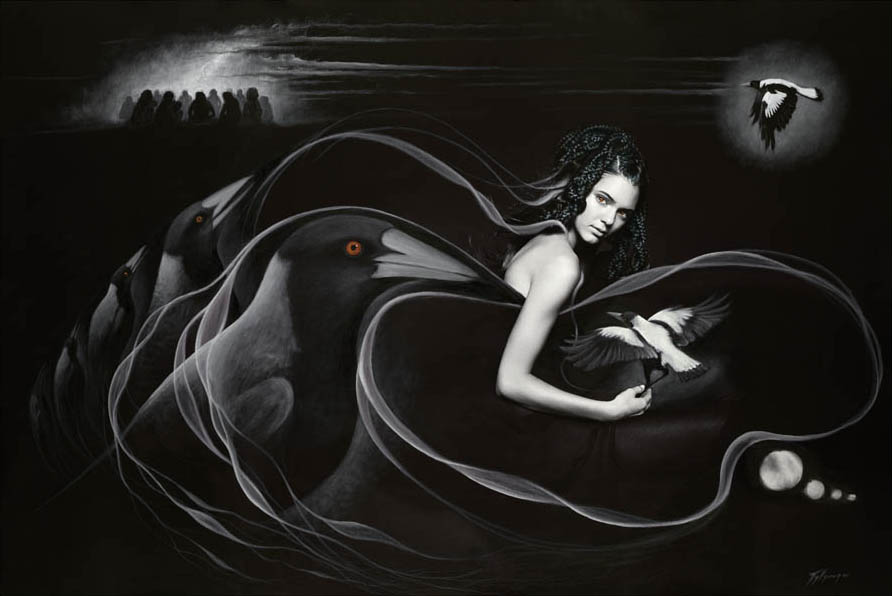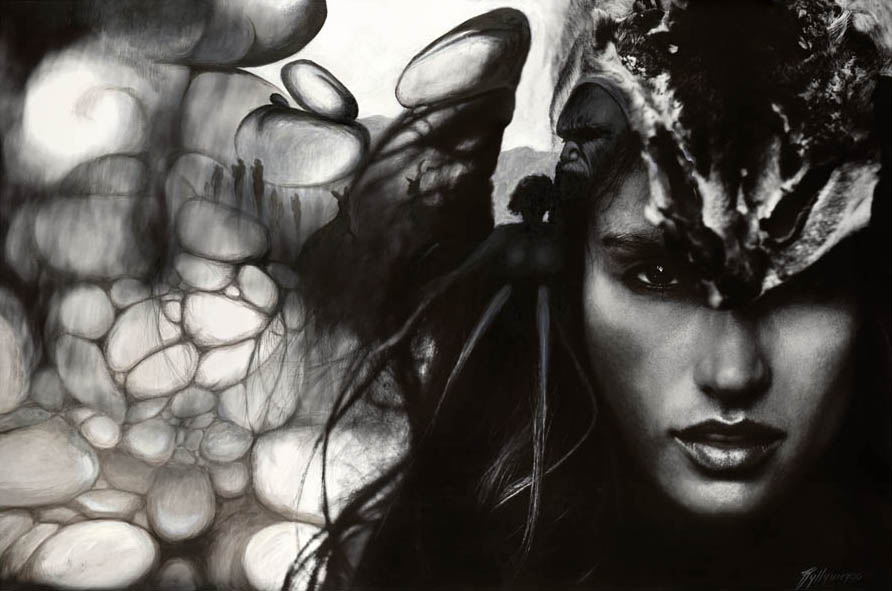Lance Chadd

Lance paints under his tribal name 'Tjyllyungoo' (elder man / wisdom / law) and has been a leading Noongar / Yamatji artist for 45 years. Lance's stunning landscapes have been highly acclaimed in Australia, America and Japan. His works can be found in many private collections, including the art gallery of Western Australia and the Berndt Museum collection. Lance has been the recipient of an extensive list of awards, including the Australia Council Fellowship, Naidoc Artist of the Year and the BHP Acquisitive award for excellence in the 'Noongar Country' exhibition. Language Group: Noongar / Yamatji; Region: Southwest / Midwest

Djinanginy
Translation: Looking
Photograph by Russell James. Collaborative art by Lance Chadd (AUS).
4’11” x 6’4” archival pigment ink printed on rag cotton with acrylic and ochre applications.
‘This painting reminds me of teaching my Aboriginal and Whadjella (white) students the gouache (Carrolup style painting). Sometimes, while teaching, I talk about our stories of how the Balga trees (grass trees) are our fire trees. So here I’ve got the fire coming off the stem. Sometimes that stem is called ‘Murliny’, sometimes its called ‘Karriduk’ . When its ‘Karriduk’ its in association with how fire came to the Nyoongar people of the South West. A lot of the times they (students) would come to me afterwards and say ‘After doing that gouache, I’ve been seeing that country, these paintings, everywhere I go’. So they have this new awareness. Looking at country and recognizing things from what I have taught them in the painting workshops.
These earthy colored waving lines here, represent the rhythm in the land, the vibrations in the land and the different moods in the land. When you look at those eyes here, you think to yourself, well, we are never alone, and in our culture, as far as your totemic spirit, your ‘Boorungar’, your spiritual guardian, he’s with you all the time. The world may think of Jesus or God or Creator as the wholly spirit with you all the time. Ours is a land-based spirituality, its here in the birds and animals and plants and fish, all things related to true totemic spirituality. There’s a feeling of never being alone. These lines in the painting also represent the great snake and how he move’s. The ‘Wargyl’, the Rainbow serpent. He’s the creator of our rivers and waterways. He’s in the wind and in the flowing of water. He can be wherever’.

Noonka Kaanya
Translation: No shame.
Photograph by Russell James. Collaborative art by Lance Chadd (AUS).
4’11” x 6’4” archival pigment ink printed on rag cotton with acrylic and ochre applications.
This painting is where I met my own inhibitions. I felt restrained, blocked suppressed in trying to fit my own expression of inhibition with an image that is conceptually foreign to my understanding of that word. The dictionary definition of Inhibition states: ‘The weakening of a learned response usually as a result of extinction or because of the presence of a distraction stimulus.’ This reminds me of our culture and its near extinction. The distraction of Whadjella stimulus, Whadjella systems and ways. Monetary values devoid of land based spirituality. Destructive of our Mother (land), foreign and destructive to my people. It reminds me of Aboriginal people trying to fit into mainstream. Into a Whadjella world. We try and fit in terms of acceptance and equality and having the same kind of rights as everybody else. Access and respect as everybody else. In our history, people like the famous Aboriginal artist ‘Albert Nammatjirra’ was restricted from buying land or buying a house or travelling to his own exhibition , and so restrictions are major ‘conditioned’ inhibitions for Aboriginal people in that sense. Things are changing. Art as an uncensored medium, is freedom and a powerful expression, with potential that can change things for the better in all kinds of areas and then it’s a great thing! It’s a different voice and smart Psychology, a way of getting things across without building walls straight away, in fact breaking down those barriers.
The minimal amount I have painted on this image, of ‘Wirin’ ( spirit figure ) and the land, representing culture, clearly expresses my own inhibitions and restrictions.

York
Translation: Woman
Photograph by Russell James. Collaborative art by Lance Chadd (AUS).
4’11” x 6’4” archival pigment ink printed on rag cotton with acrylic and ochre applications.
‘I’ve added little to this image. I like the shapes and curves of the female form and so I have tried to maintain that by following the lines and enhancing what is already there. So it is sensual. She is a beautiful woman and has a beautiful body. The innocence in this image is the model herself. She is innocent to how some may perceive her body.
This painting will make people look at the beauty of female form and I don’t know where from there’.

Ni!
Translation: Stop, look & listen.
Photograph by Russell James. Collaborative art by Lance Chadd (AUS).
4’11” x 6’4” archival pigment ink printed on rag cotton with acrylic and ochre applications.
If we say we’ve ‘discovered’ something then we take the credit for it, we name it after ourself, we claim it, but if we have the attitude that whatever we come across has been ‘revealed’ to us, it was there all the time, then we don’t take the credit. We are grateful, thankful and give appreciation to whoever put these things in place. ( the creator, spirit or god ) I believe we have a need to be grateful, somewhere in our soul which asks the question, to who? I find things are ‘revealed’ to me when I’m looking or searching. I’m in that humility, in that learning mode and so then ‘more’ truths are revealed, because of that humility. The ‘I’ in the claim of discovery, the pride, is the opposite to humility. ‘Even our old people – I remember hearing my Dad and them saying, old ‘Marbarn’ men or doctor in our culture. He heals people spiritually. If they misuse that gift that they got, then that would be taken away from them. If they get proud or arrogant, it’ll leave them like their shadow and walk away from them, dad used to say.’
These circles in this painting represent the three stages of her life again. It starts with the young girl, then woman, then elder or grandmother. It’s herself, her life, her heart, her soul, her spirit. The light’s, are the truths revealed to her. Its not just something in her head, it will go to her heart and truth is food for the soul. It’s what nurtures it, what edifies it.

Koort
Translation: Heart
Photograph by Russell James. Collaborative art by Lance Chadd (AUS).
4’11” x 6’4” archival pigment ink printed on rag cotton with acrylic and ochre applications.
‘Koort’ , has an innocent face, its good and its kind and I think that people like that, who do eventually experience some Aboriginal culture and talk to Aboriginal people will find that they have a lot of intelligent wisdom and good humor that they don’t mind sharing. These people will learn to appreciate that the first Australians back then, were intelligent people with a culture and spirituality rich in respect for land and environment. Knowledge and wisdom we could all learn from today. This color and circles here, represent the culture or elements of a persons life. Or times of a persons life. Or three individual people, like Daughter, Mother and Grandmother. Or ones life at different stages. Like, when they are a girl, then when they are a woman and then when they are an elder. When people share cultures, you get a merging like we have today. We have merged here with white people photos and white peoples paints and that, but using that to represent culture, and small things like this here (smaller shapes) represent connections as well, between cultures and sharing’s. I turned this image around and I saw her looking at it’. (Aboriginal culture).

Bwora
Translation: Inside
Photograph by Russell James. Collaborative art by Lance Chadd (AUS).
4’11” x 6’4” archival pigment ink printed on rag cotton with acrylic and ochre applications.
In this painting, she’s entangled which is a form of inhibition, and reaching for something deeper. Trying to break out of her restrictions. This larger form here ( stone shape) is something forming in the woman , something growing that she is a part of . She is searching and reaching into the depths of herself, as far as she can go. She is still feeling it out , she’s not sure for what. The upper and lower half circles represent the balance in life that she is trying to achieve. There is also a self embracing and supportive structure formed within herself during this process, that allows more flexibility in her life.

Moolap
Translation: Now knowing.
Photograph by Russell James. Collaborative art by Lance Chadd (AUS).
4’11” x 6’4” archival pigment ink printed on rag cotton with acrylic and ochre applications.
‘Today we were looking at those Kangaroos, about 20 or more hopping that way and there’s that one big fella leading them and he’s on the other side of the paddock. They all come as far as the fence and they stopped. He stopped because they weren’t following him and looked back, but it was because of the fence that they were restricted. They couldn’t go anywhere. That big Boomer ( Old male Kangaroo ) standing there looking back at them. Waiting’. I think there were probably a lot of people, back earlier,that were interested in Aboriginal culture but were inhibited or restricted a lot by their piers attitudes. Their families or friends may not have approved. Our culture has become more appreciated in recent times, particularly through tourism, International interest and the arts. It’s all right now for people to be interested, it’s more widely accepted. Our people should be valued, more because of who they are and their history of this place and when people learn the culture through experience and sharing, they will develop more appreciation for ‘life’. Things are changing. ‘Moolap’ is about someone who has had an awareness of culture, something’s taking time to understand ( light areas varying in brightness ) Some things are taken to heart ( hand gesture ). Through cultural knowledge, people start to appreciate land, animals etc. The more they learn about culture and Aboriginal spirituality in relation to land and totemic beings and how they are related to land and place and environment. The more they will appreciate it, respect it and care for it.

KULDJUK BOORANGUR
Photograph by Russell James. Collaborative art by Lance Chadd (AUS).
40” x 60” archival pigment ink printed on rag cotton with acrylic and ochre applications.
‘Kuldjuk Boorangur’ is the great Black Swan Totem ( Spiritual Elder Brother ) of the ‘Bibbulman’ people. ( Aboriginals of the South Western Australia.) He came into being during the ‘Ngyddiny – Koorah Koorah’ (cold times of long ago.) As the swans were changed into Nyoongar (men ), the Spirit Kuldjuk told them that the swan was to be their ‘Boorangur’ (elder brother ) Special ceremonies would be performed at ‘Winaatj’ ( a sacred place), were they would decorate their bodies with down from their ‘elder brother’, and sing swan songs and dance the motions of the swan gathering their nest materials. This ceremony ensured great flocks of swans and plenty of food for the great gathering of their ‘Moorurtung’ and ‘Weea- binuk’, (blood relations and relations-in-law) , for the egg feast and the many ‘Ke-ning’ (corroborees ) given by the visitors. The ‘Kangaroo men’ from the North-East, the ‘Possum men’ from the East and the ‘Gum and Honey and Root men’ from the South.

COOLBARDI MOONLIGHT LOVE SONG
Photograph by Russell James. Collaborative art by Lance Chadd (AUS).
40” x 60” archival pigment ink printed on rag cotton with acrylic and ochre applications.
Coolbardi ( Magpie ) who sings for separated lovers who share one moon as a bridge, joining one heart to
another. The male Coolbardi in her hand and in the moon, is the one she loves and longs for. Our old people
are around the fire, where stories are told. For the fire is the story and the smoke is the telling of it.

BELONGING
Photograph by Russell James. Collaborative art by Lance Chadd (AUS).
40” x 60” archival pigment ink printed on rag cotton with acrylic and ochre applications.

Bangalanga
Translation: Exchange
Photograph by Russell James. Collaborative art by Lance Chadd (AUS).
4’11” x 6’4” archival pigment ink printed on rag cotton with acrylic and ochre applications.
Here I’ve got the brown eye on one side representing the brown or black people, and blue eye on the other side, representing white people or Whadjella’s. I’ve placed the other shoulder in here to balance it up with the original, so that we have an equality. I’ve also lightened one side to represent the white person and darkened the other to represent the black person. So I have the Whadjella eye looking from a black persons perspective and a black person looking from the Whadjella’s perspective.
There is a sharing and understanding of some sort. A merging and collaboration. It also suggests that it’s not just black and white! You need to start to see from the other cultures point of view in order to understand. If they’re looking, this one into that culture and this one into that culture and they’re sharing, so there develops an equality and a mutual respect. Which can only come from what is revealed in that relationship. We all have red blood! The more one looks, shares and understands of another culture the more they discover or have revealed about themselves.